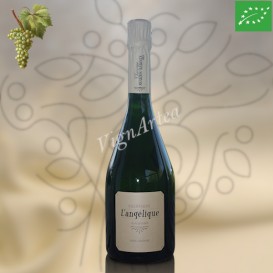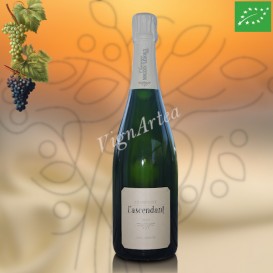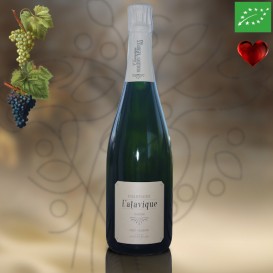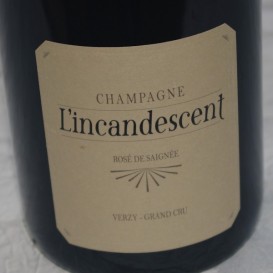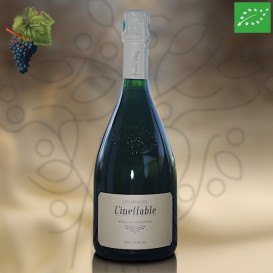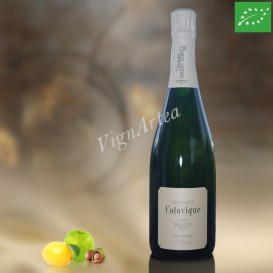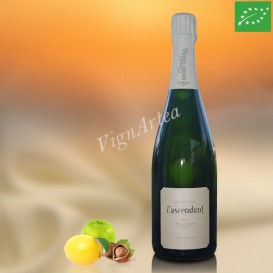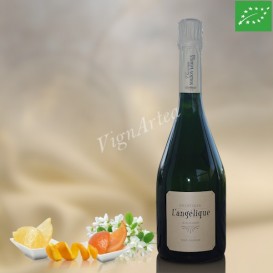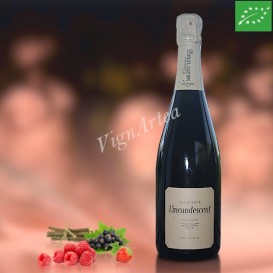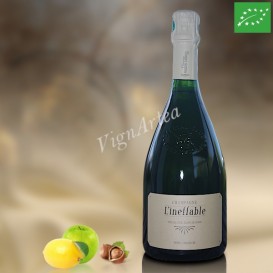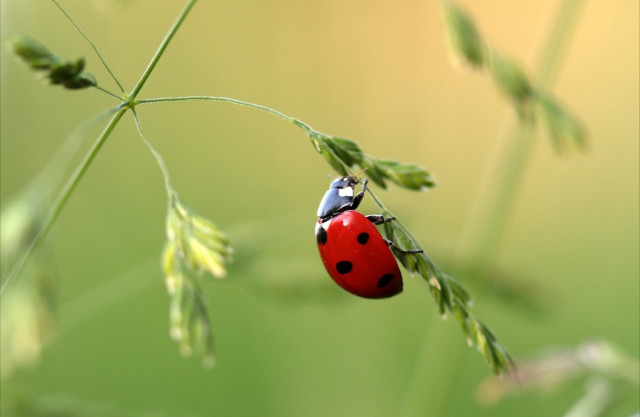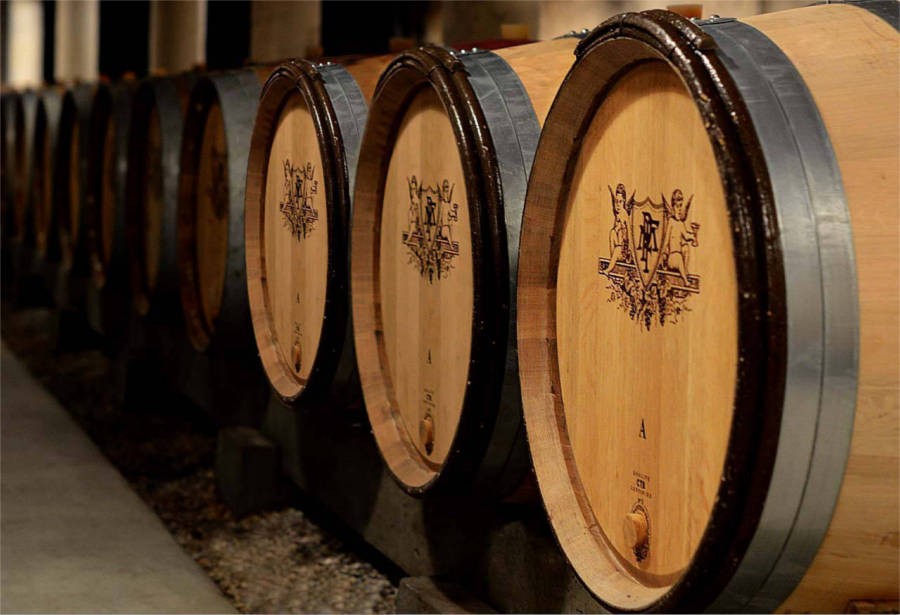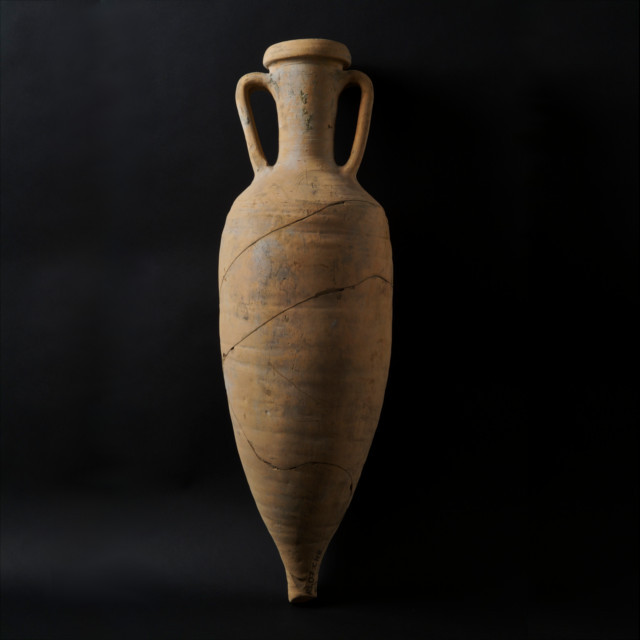Champagne MOUZON-LEROUX

CHAMPAGNE MONTAGNE DE REIMS 8 ha CERTIFIED ORGANIC FARMING WINEMAKER : Sébastien MOUZON-LEROUX
ESTATE HISTORY
The Champagne MOUZON-LEROUX is located in the heart of Verzy, on the exceptional Montagne de Reims vineyard where are produced very high quality wines. The landscapes open on the chalky plain, and the slopes where the vines extend are surmounted by woods, among which there is a curiosity: the Faux de Verzy or twisted beeches, so called because of their tortuous trunks and branches, and for which no rational explanation could be given as to their atypical morphology peculiar to the region.
It is in this place full of mystery and legends that Sébastien MOUZON-LEROUX, the worthy representative of the fourth generation, is running the vineyard that the estate has been running from father to son since 1776, using reasoned farming practices that have progressively led the domain to a biodynamic culture in 2008. It obtained the AB Ecocert certification in 2011 : the young vines are worked with the horse, grass production are carried out by sheep and chickens in winter, and the estate introduces shrubs into the vineyards to preserve their biodiversity.
TERROIR
Sébastien is in charge of 8 ha of vines : the vineyard, very fragmented, consists of 60 parcels distributed between the Verzenay and Villers Marmery villages. Soils, of light textured, carbonated, are mainly formed on chalk and on the chalk's alteration, with many slope-wash products. The grape variety consists of a majority of Pinot Noir (60%) planted on the plots located west of Verzy, on Verzenay and Mailly-Champagne villages side, where the soil has a very thick clays layer covering the chalk.
Chardonnay vines (35% of the grape variety) are located east of Verzy, on Villers Marmery and Trépail villages side, where the substrate is lighter and the chalk outcrops, ideal for this variety. The remaining 5% of the vines consist of Arbanne, Petit Meslier, Pinot Blanc and Pinot Gris vines.
WINEGROWING & WINEMAKING
In the cellar, Sébastien wants keep intervention to the minimum during the different winemaking steps, while ensuring the highest quality for his champagnes. For this, only the harvest, picked at optimum maturity and sorted by cluster, is treat with sulphite. The cuvée (juice obtained after the three first pressing) and the taille (juice obtained after the forth and fifth pressing) are used. The undecanted must is directly put in barrels after pressing.
All fermentations are made in with native microorganisms. The preparation of a native yeasts sourdough starter is systematic to ensure a dynamic alcoholic fermentation's start, because the latter is conditionning all the following winemaking steps. For that, a first grapes picking is carried out before the official harvest and put in fermentation for the production of 50 liters of leaven; a second grape picking is made two or three days later to prepare an additional 600 liters of yeast : at the end, 650 liters of bubbling yeast is available to seed the vats.
The musts make their malolactic fermentation, Sebastien does not want to inhibit it in order to avoid treating the champagnes with sulphites.
The wines are then aged on lees in oak barrels or in vats for 6 months, they are then bottled, without fining or filtering, for the second fermentation and is matured on slats from 24 months to 6 years depending on the champagne. After disgorging, sugar is added with rectified concentrated must to compensate for the liquid loss caused by the dead yeasts expulsion. The wines are aged for another 6 months in the cellar in order the liqueur de dosage to be integrated and the wine stabilized.
This estate is a beautiful discovery, champagnes are well-balanced and very delicate, attesting to a perfect control of the winemaking.
-
L'ANGELIQUE 2017 (Champagne MOUZON-LEROUX)
65,20 € In stock!MONTAGNE DE REIMS - AOP CHAMPAGNE - WHITE BLANC DE BLANCS CHAMPAGNE
Grape variety: Chardonnay (100%)
Extra-Brut Grand Cru Sugar addition : 1,5 g/l
Fresh - Delicate - Tense
- Nose: fresh and delicate. Lovely notes of crisp green apples with a hint of lemon and almond
- Palate: tense, lovely lemony texture. Fine bubbles
- Tasting date: January 2025
- OUR OPINION: the nose is very pretty, with notes of crunchy apples! This vintage is best suited to lovers of taut champagnes.
The exceptional bottle's weight (1.8kg) may result in higher shipping costs for the final shopping cart.
Other vintage available:
- Nose: fresh and delicate. Lovely notes of crisp green apples with a hint of lemon and almond
-
L'ASCENDANT BASE 2018 (Champagne MOUZON-LEROUX)
53,50 € In stock!MONTAGNE DE REIMS - AOP CHAMPAGNE - WHITE CHAMPAGNE
Grape varieties: Pinot Noir (60%) - Chardonnay (40%)
Brut Nature Grand Cru Sugar addition : 0 g/l
Well-balanced - Fresh - Tasty
- Nose: lively and crystalline. Notes of brioche, candied citrus fruit, mandarin and a hint of quince paste.
- Palate: dynamic attack. Fresh and taut on the palate. Lime finish.
- Tasting date: November 2024.
- OUR OPINION: a Solera of great aromatic complexity, offering great freshness and minerality on the palate. Taut and tasty at the same time.
Other base available:
The exceptional bottle's weight (1.8kg) may result in higher shipping costs for the final shopping cart.
- Nose: lively and crystalline. Notes of brioche, candied citrus fruit, mandarin and a hint of quince paste.
-
L'ATAVIQUE BASE 2020 (Champagne MOUZON-LEROUX)
40,90 € In stock!MONTAGNE DE REIMS - AOP CHAMPAGNE - WHITE CHAMPAGNE
Grape varieties: Pinot Noir (65%) - Chardonnay (35%)
Brut Nature Grand Cru Sugar addition : 0 g/l
Cristallin - Fresh - Fine
- Color: golden yellow.
- Nose: fresh and delicate. Notes of lemon, white grapefruit, green apples with a hint of brioche.
- Palate: Fine bubbles. Fresh, thirst-quenching juice, perfectly balanced. A hint of tangerine on the finish.
- Tasting date: November 2024.
- OUR OPINION: a vintage that is tighter than its predecessors, crystalline and very fresh. Very classy with great finesse, I really like it, it's a great success! ❤️❤️
The exceptional bottle's weight (1.8kg) may result in higher shipping costs for the final shopping cart.
Other base available:
- Color: golden yellow.
-
L'INCANDESCENT R-2019 (Champagne MOUZON-LEROUX)
49,20 € In stock!MONTAGNE DE REIMS - AOP CHAMPAGNE - ROSÉ CHAMPAGNE
Grape variety: Pinot Noir (100%)
Brut Nature Grand Cru Sugar addition : 0 g/l
Well-balanced - Fresh - Fruity
- Color: attractive raspberry-red tending to orange.
- Nose: fruity. Notes of blackcurrant, morello cherry and hawthorn blossom with a hint of mint.
- Palate: lively and fresh, with a lovely blackcurrant coulis finish. Long-lasting aromas.
- Tasting date: December 2024.
- OUR OPINION: with its lovely, almost red colour, this vintage is fruity, very pleasant and thirst-quenching. Its richness makes it a real mealtime champagne. ❤️ A real favourite! ❤️
The exceptional bottle's weight (1.8kg) may result in higher shipping costs for the final shopping cart.
Other harvest available:
- Color: attractive raspberry-red tending to orange.
-
L'INEFFABLE 2017 (Champagne MOUZON-LEROUX)
65,20 € In stock!MONTAGNE DE REIMS - AOP CHAMPAGNE - WHITE BLANC DE NOIRS CHAMPAGNE
Grape variety: Pinot Noir (100%)
Brut Nature Grand Cru Sugar addition : 0 g/l
Fresh - Mineral - Taut
- Nose: fresh and mineral. Notes of lemon, white grapefruit, some brioche and a hint of green apple.
- Palate: lively, clean attack. Fine bubbles. Praline and lemon notes. Long finish.
- Tasting date: January 2025.
- OUR OPINION: a citrus-dominated vintage for lovers of taut champagnes.
The exceptional bottle's weight (1.8kg) may result in higher shipping costs for the final shopping cart.
Other vintage available:
- Nose: fresh and mineral. Notes of lemon, white grapefruit, some brioche and a hint of green apple.
-
L'ATAVIQUE BASE 2019 (Champagne MOUZON-LEROUX)
38,00 € In stock!MONTAGNE DE REIMS - AOP CHAMPAGNE - WHITE CHAMPAGNE
Grape varieties: Pinot Noir (60%) - Chardonnay (40%)
Brut Nature Grand Cru
Complex - Fresh - Well-balanced
- Nose: tasty and fresh. Intense notes of green granny apple, lime, with some brioche notes and a touch of candied orange
- Palate: tonic and tasty. The bubble is almost imperceptible
- Tasting date: April 2023
- OUR OPINION: a beautiful and refined cuvée, with a complex and salivating juice. Perfect!
Other base available:
The exceptional bottle's weight (1.8kg) may result in higher shipping costs for the final shopping cart.
- Nose: tasty and fresh. Intense notes of green granny apple, lime, with some brioche notes and a touch of candied orange
-
L'ASCENDANT BASE 2017 (Champagne MOUZON-LEROUX)
49,50 € In stock!MONTAGNE DE REIMS - AOP CHAMPAGNE - WHITE CHAMPAGNE
Grape varieties: Pinot Noir (60%) - Chardonnay (40%)
Extra-Brut Grand Cru Sugar addition: 1 g/l
- Nose: fresh and fruity. Notes of brioche, green apple, candied citrus fruit, praline with a hint of coriander
- Palate: fine bubbles. Clean, lively and salivating attack. Long-lasting aromas
- Tasting date: July 2023
- OUR OPINION: a lot of freshness and tonicity for this solera champagne with gourmet aromas. For lovers of lively and taut champagnes.
Other base available:
The exceptional bottle's weight (1.8kg) may result in higher shipping costs for the final shopping cart.
- Nose: fresh and fruity. Notes of brioche, green apple, candied citrus fruit, praline with a hint of coriander
-
L'ANGELIQUE 2016 (Champagne MOUZON-LEROUX)
61,00 € In stock!MONTAGNE DE REIMS - AOP CHAMPAGNE - BLANC DE BLANCS CHAMPAGNE
Grape variety: Chardonnay (100%)
Brut Nature Grand Cru Vintage
Sugar addition: 0 g/l- Nose: elegant and smooth. Brioche and floral notes. Fragrance of white flowers, candied citrus fruits, orange peel.
- Palate: tonic, fresh and salivating. Beautiful aromatic persistence.
- Tasting date: November 2022.
- OUR OPINION: a very fine vintage, rich and complex. I particularly like the candied fruit flavour, a real delicacy that cannot be found in previous vintages. It is fresh and very sapid!
Other vintage available:
The exceptional bottle's weight (1.8kg) may result in higher shipping costs for the final shopping cart.
- Nose: elegant and smooth. Brioche and floral notes. Fragrance of white flowers, candied citrus fruits, orange peel.
-
L'INCANDESCENT R-2018 (Champagne MOUZON-LEROUX)
46,00 € In stock!MONTAGNE DE REIMS - AOP CHAMPAGNE - ROSÉ CHAMPAGNE
Grape variety: Pinot Noir (100%)
Extra Brut Grand Cru Sugar addition: 1,5 g/l
- Color: very nice grenadine-like red
- Nose: fresh and crisp. A real infusion of red fruits with notes of redcurrant, strawberry, grenadine with a hint of blackcurrant bud and violet
- Palate: fresh and floral. Fine bubbles
- Tasting date: October 2022.
- OUR OPINION: this vintage has great finesse and freshness. It is a real infusion of red fruits, a delicate champagne of great elegance. Superb!
Other base available:
The exceptional bottle's weight (1.8kg) may result in higher shipping costs for the final shopping cart.
- Color: very nice grenadine-like red
-
L'INEFFABLE 2016 (Champagne MOUZON-LEROUX)
59,90 € In stock!MONTAGNE DE REIMS - AOP CHAMPAGNE - BLANC DE NOIRS CHAMPAGNE
Grape variety: Pinot (100%)
Brut Nature Grand Cru Sugar addition: 0 g/l Vintage
- Nose: fragrant. Notes of brioche and praline, aromas of lemon and green apple with a hint of hazelnut
- Palate: lively and tonic attack. Bubbles barely perceptible. Long lemony finish
- Tasting date: October 2022
- OUR OPINION: a very successful vintage, perfectly balanced and nicely perfumed. Intended for lovers of rather lively champagnes
Other vintage available:
The exceptional bottle's weight (1.8kg) may result in higher shipping costs for the final shopping cart.
- Nose: fragrant. Notes of brioche and praline, aromas of lemon and green apple with a hint of hazelnut

